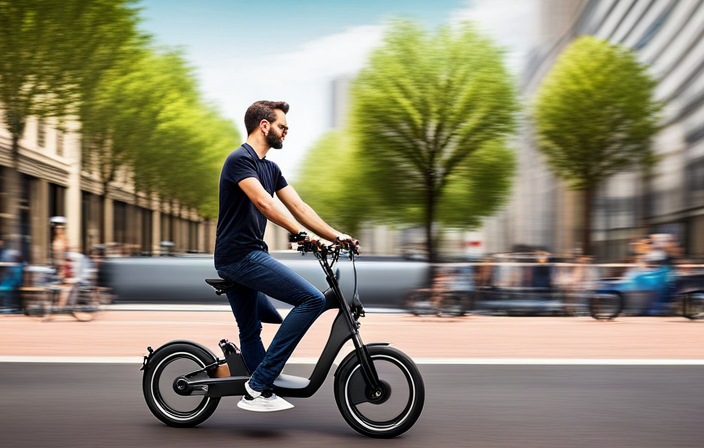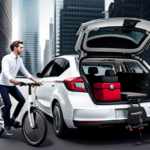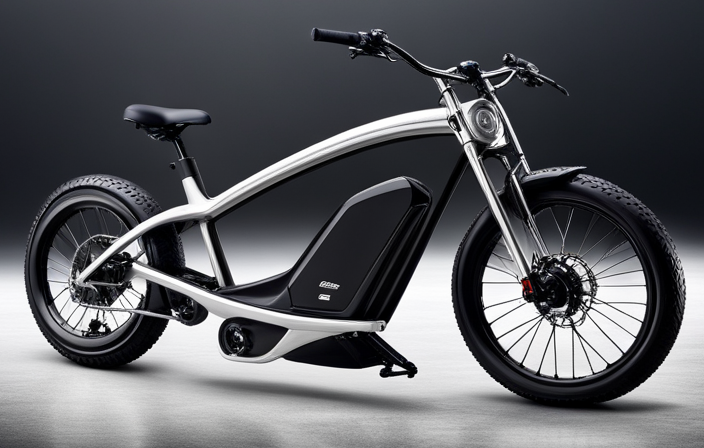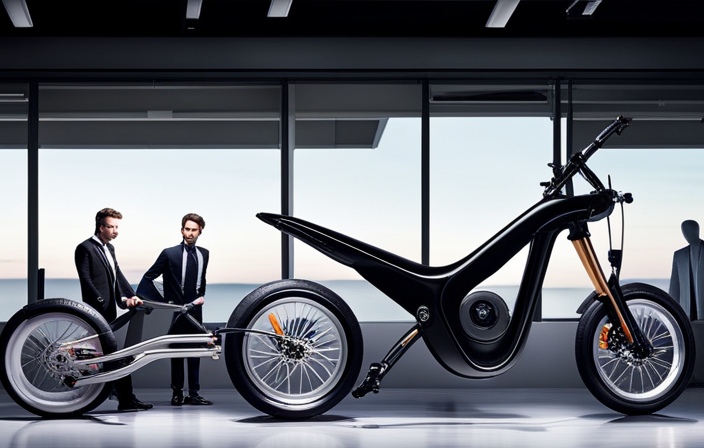Are you tired of lugging around your electric bike every time you want to go for a ride? Well, fear not, because I have the perfect solution for you!
In this article, I will be diving into the world of bike carriers and exploring the best options specifically designed for electric bikes.
From hitch-mounted carriers to foldable ones, we will explore durability, ease of installation, and user reviews to help you find the perfect carrier for your electric bike.
So hop on, and let’s find the best way to transport your electric bike hassle-free!
Key Takeaways
- Hitch-mounted bike carriers are a popular choice for electric bikes.
- Look for a bike carrier with a high weight capacity to accommodate the heavier electric bikes.
- Consider a platform-style bike carrier for easy loading and unloading of electric bikes.
- Check for locking mechanisms to ensure the security of your electric bikes during transport.
Hitch-mounted bike carriers
The best bike carrier for electric bikes is the hitch-mounted bike carrier. Hitch-mounted bike carriers are specifically designed to attach to the hitch receiver on the back of your vehicle, providing a secure and stable platform for transporting your electric bikes. One of the main advantages of hitch-mounted bike carriers is their ease of use. They are quick and simple to install, and they can carry multiple bikes without any hassle.
Additionally, they offer better ground clearance compared to roof-mounted carriers, reducing the risk of damage when going over bumps or dips in the road. However, one downside of hitch-mounted carriers is that they can obstruct access to the trunk or rear hatch of your vehicle.
In the next section, we will explore the alternative option of roof-mounted bike carriers.
Roof-mounted bike carriers
For a convenient option, you might consider using a roof-mounted bike carrier for your e-bike. Roof mounted bike carriers have their own set of advantages and disadvantages. Here are some pros and cons to help you make an informed decision:
Pros:
- They allow easy access to your trunk or rear hatch.
- They don’t obstruct your rear visibility.
- They can accommodate multiple bikes.
- They are compatible with various bike sizes and styles.
Cons:
- They can be more difficult to load and unload.
- They may require additional equipment, such as crossbars or roof racks.
- They can increase the overall height of your vehicle.
Recommended brands for roof-mounted bike carriers include Thule, Yakima, and Saris. These brands offer sturdy and reliable options that can securely transport your e-bike.
Now, let’s transition into the subsequent section about trunk-mounted bike carriers.
Trunk-mounted bike carriers
Trunk-mounted bike carriers are an affordable and versatile option for transporting bikes. They are easy to install and remove, making them convenient for those who frequently use their bike carriers.
Additionally, trunk-mounted carriers can accommodate different bike sizes, making them suitable for a variety of bikes.
Affordable and versatile option
Looking for an affordable and versatile option? You can’t go wrong with a hitch-mounted bike carrier for electric bikes. This type of bike carrier offers great portability and storage, allowing you to easily transport your electric bikes wherever you go. It’s also incredibly easy to use and maneuver, making it a convenient choice for all types of riders.
The hitch-mounted bike carrier provides a secure and stable platform for your bikes, ensuring they stay in place during transportation. It allows for quick and easy loading and unloading of your electric bikes, saving you time and effort. With its adjustable features, this bike carrier can accommodate different sizes and styles of electric bikes, making it a versatile option for all riders.
With its affordable price tag and impressive features, the hitch-mounted bike carrier is a top choice for electric bike enthusiasts.
Next, let’s explore the benefits of easy installation and removal for this type of bike carrier.
Easy installation and removal
With its simple installation and removal process, the hitch-mounted bike carrier is a convenient choice for transporting your electric bikes. The installation process is straightforward and requires minimal effort. The carrier easily attaches to the hitch receiver of your vehicle, ensuring a secure and stable connection.
To remove the carrier, simply follow the reverse steps, making it quick and hassle-free. This ease of installation and removal is particularly beneficial for those who frequently need to switch between using the carrier and having an empty hitch receiver.
Additionally, the hitch-mounted bike carrier is designed to accommodate different bike sizes, making it versatile and suitable for a variety of electric bikes. From smaller folding bikes to larger mountain bikes, this carrier can handle them all.
Can accommodate different bike sizes
The hitch-mounted bike carrier is versatile and can handle a variety of different-sized bikes. It is designed to be compatible with various bike frames and sizes, making it the ideal choice for electric bikes.
The adjustable bike racks can be easily customized to accommodate different bike sizes, ensuring a secure and stable fit during transportation. This is especially important for electric bikes, as they tend to be heavier and bulkier than traditional bikes.
The bike carrier’s compatibility and adjustability allow for a hassle-free installation and removal process, saving valuable time and effort.
Now that we have covered the versatility of hitch-mounted bike carriers, let’s move on to the next section about platform-style bike carriers.
Platform-style bike carriers
One popular option for carrying electric bikes is a platform-style bike carrier. These carriers are designed to securely hold the bikes in place while providing easy loading and unloading. They can accommodate different bike sizes and are known for their stability and durability.
One key feature of platform-style bike carriers is their ability to distribute the weight of the bikes evenly. This is important when carrying electric bikes, as they can be heavier than traditional bikes due to the added weight of the battery. The even weight distribution helps to prevent strain on the carrier and ensures a smooth and safe ride.
Another important feature of platform-style bike carriers is their anti-sway technology. This technology helps to minimize any side-to-side movement of the bikes during transportation, reducing the risk of damage or shifting during transit.
In conclusion, platform-style bike carriers are a popular choice for carrying electric bikes due to their ability to accommodate different bike sizes, even weight distribution, and anti-sway technology. They provide a secure and reliable option for transporting electric bikes.
Moving on to foldable bike carriers…
Foldable bike carriers
When looking for a convenient option to transport your foldable bike, you may want to consider a foldable bike carrier. Foldable bike carriers are specifically designed to accommodate the unique needs of foldable bikes. These carriers are lightweight and easy to use, making them a great choice for anyone who values portability and convenience.
They typically feature a compact design that allows for easy storage when not in use. Some foldable bike carriers even come with built-in carrying handles, making it even easier to transport your bike. With a foldable bike carrier, you can take your electric bike on the go without any hassle.
Now let’s move on to the next section about ’tilting bike carriers’ which offer additional functionality for your transportation needs.
Tilting bike carriers
Tilting bike carriers provide added convenience and functionality for transporting your foldable bike. One of the main advantages of a tilting bike carrier is that it allows you to easily access your vehicle’s trunk or hatchback without having to remove the entire carrier or bikes. This is especially useful when you need to grab something quickly or when you’re on a road trip and need to make frequent stops.
Additionally, tilting bike carriers usually have a lower loading height, making it easier to load and unload your bikes. However, there are a few disadvantages to consider. Tilting bike carriers tend to be more expensive than non-tilting options, and they may not be as stable when fully loaded.
Overall, a tilting bike carrier is a great option if you value convenience and easy access to your vehicle’s trunk.
Moving on to wheel-mount bike carriers, they offer their own set of advantages and disadvantages.
Wheel-mount bike carriers
When it comes to transporting electric bikes, there are various options available. In the previous subtopic, we discussed tilting bike carriers. Now, let’s shift our focus to wheel-mount bike carriers. These carriers are designed to securely hold the electric bikes by their wheels, providing a stable and safe transportation solution.
One of the advantages of wheel-mount bike carriers is their foldable storage feature. This allows you to easily store the carrier when not in use, saving valuable space. Additionally, many wheel-mount carriers come equipped with anti-theft features such as locks and security cables, providing added peace of mind.
To help you visualize the different features and compare options, here is a table outlining the key features of wheel-mount bike carriers:
| Features |
|---|
| Foldable storage |
| Anti-theft features |
Now, let’s explore the next subtopic and learn about vertical bike carriers, which offer yet another convenient option for transporting electric bikes.
Vertical bike carriers
If you’re looking for a different option for transporting your electric bikes, vertical bike carriers provide a convenient solution. These carriers have several benefits that make them a great choice for transporting electric bikes.
Firstly, vertical carriers allow for easy loading and unloading of bikes, as they hold the bikes upright and secure them with adjustable straps or clamps. This eliminates the need to lift heavy bikes onto a roof or maneuver them onto a wheel-mount carrier.
Additionally, vertical carriers are often more compact and lightweight than other types of bike carriers, making them easier to install and store when not in use.
When choosing the right vertical bike carrier, consider factors such as weight capacity, compatibility with your electric bike’s frame design, and ease of installation.
Transitioning into the subsequent section about ‘locking mechanisms,’ it’s important to ensure your vertical bike carrier has a reliable and secure locking system for added safety and peace of mind.
Locking mechanisms
When it comes to vertical bike carriers, one important aspect to consider is the locking mechanism. A good locking mechanism ensures that your electric bikes are securely held in place during transportation, giving you peace of mind knowing that they won’t fall or get damaged.
There are different types of locking mechanisms available in bike carriers, such as adjustable straps, clamps, or even built-in locks. These mechanisms provide added stability and prevent any wobbling or movement of the bikes while on the road.
The benefits of locking mechanisms in bike carriers are numerous. They not only protect your electric bikes from theft but also keep them safe from any accidental bumps or jostling during transit. Additionally, they allow for easy loading and unloading of the bikes, making the whole process much more convenient.
Now, let’s move on to the next important aspect of bike carrier comparison – compatibility with different vehicle types.
Compatibility with different vehicle types
When it comes to choosing a bike carrier for electric bikes, compatibility with different vehicle types is an important consideration. The best bike carriers are designed to be suitable for cars, SUVs, and trucks, offering versatility and convenience for all types of vehicles.
Additionally, these carriers can be used with different hitch sizes, ensuring a secure fit no matter what type of hitch your vehicle has.
Moreover, they are also compatible with various roof rack systems, allowing you to easily transport your electric bikes on the roof of your vehicle.
Suitable for cars, SUVs, and trucks
You can easily find a bike carrier that is suitable for cars, SUVs, and trucks. When it comes to electric bike compatibility, it is important to choose a carrier that can securely hold the extra weight and size of an electric bike.
Here are four key features to look for in a bike carrier for cars, SUVs, and trucks:
-
Sturdy construction: A carrier with a strong frame and durable materials will ensure that your electric bike remains secure during transportation.
-
Easy loading and unloading: Look for a carrier that offers a user-friendly design, such as adjustable trays or ramps, to make it easier to load and unload your electric bike.
-
Secure attachment: A carrier with a reliable attachment system, such as straps or clamps, will keep your electric bike stable and prevent it from shifting during transit.
-
Versatility: Choose a carrier that can accommodate various vehicle types, including cars, SUVs, and trucks, to ensure you can use it with multiple vehicles.
With a bike carrier that offers these features, you can easily transport your electric bike with peace of mind. Additionally, many carriers can be used with different hitch sizes, providing flexibility for your specific vehicle setup.
Can be used with different hitch sizes
If you have a vehicle with a different hitch size, there are bike carriers available that can accommodate your specific setup. These bike carriers are designed with hitch sizes compatibility in mind, ensuring that you can easily attach them to your vehicle without any hassle.
The versatility and adaptability of these carriers allow you to use them with different hitch sizes, whether you have a smaller or larger hitch. They are equipped with adjustable features that can be customized to fit your specific hitch size, providing a secure and stable attachment. This ensures that your electric bikes are safely transported without any risk of damage.
With these bike carriers, you can easily switch between vehicles or upgrade your hitch size without having to invest in a new carrier.
Now, let’s move on to the next section, where we’ll discuss how these carriers accommodate various roof rack systems.
Accommodates various roof rack systems
The versatility of these carriers allows them to accommodate various roof rack systems. This is a crucial feature for those who own different types of vehicles or frequently switch between different roof rack setups. Whether you have a factory-installed roof rack or an aftermarket one, these bike carriers are designed to be compatible with a wide range of systems. This means that you don’t have to worry about purchasing a separate carrier for each type of roof rack you may encounter.
When it comes to roof rack compatibility, there are several bike carrier options available. Some carriers attach directly to the roof rack bars, providing a secure and stable platform for your electric bikes. Others use a clamp or mounting system to attach to the crossbars of the roof rack. Regardless of the specific design, these carriers are built to safely transport your electric bikes without damaging your roof rack.
Transitioning to the subsequent section about weight capacity, it’s important to consider the load-bearing capabilities of these bike carriers.
Weight capacity
One crucial factor to consider when choosing a bike carrier for electric bikes is its weight capacity. It is important to ensure that the carrier can safely support the weight of your electric bike.
Here are some considerations for choosing a bike carrier based on electric bike weight capacity:
-
Importance of weight distribution for electric bike carriers: Proper weight distribution is essential for a smooth and stable ride. Look for a carrier that evenly distributes the weight of your electric bike to prevent any imbalances.
-
Consider the weight of your electric bike: Different electric bikes have varying weights, so it is crucial to choose a carrier that can handle the weight of your specific bike. Check the weight capacity of the carrier before making a decision.
-
Look for a carrier with a high weight capacity: Opt for a carrier that has a higher weight capacity than your electric bike. This ensures that the carrier can handle the weight and provides an extra margin of safety.
-
Consider the weight of additional accessories: If you plan on carrying additional accessories such as batteries or panniers, make sure to account for their weight when choosing a carrier.
-
Check the manufacturer’s recommendations: Some bike carriers may have specific weight limits or recommendations from the manufacturer. Be sure to follow these guidelines to ensure the carrier’s durability and stability.
Considering the weight capacity of a bike carrier is crucial for a safe and reliable transportation solution for your electric bike. In addition to weight capacity, durability and stability are also important factors to consider when choosing the best bike carrier for electric bikes.
Durability and stability
When it comes to choosing a bike carrier for electric bikes, durability and stability are key factors to consider. A good bike carrier should be built to withstand road vibrations and bumps, ensuring that your electric bike remains secure and protected during transportation.
Additionally, it should provide a stable and secure platform for your electric bike, minimizing any wobbling or movement that could potentially damage the bike or affect the vehicle’s handling.
Lastly, a high-quality bike carrier will offer long-lasting performance and reliability, giving you peace of mind knowing that your investment is well-protected and will last for years to come.
Built to withstand road vibrations and bumps
Choose a bike carrier that can handle road vibrations and bumps without any issues. It is important to look for a carrier that is built with anti-vibration technology and shock-absorbing features. These features will help to minimize the effects of road vibrations and bumps, ensuring that your electric bike remains secure and protected during transportation. To give you a better understanding, let’s take a look at the table below:
| Feature | Description | Benefit |
|---|---|---|
| Anti-vibration technology | Reduces the impact of road vibrations | Provides a smoother ride for your electric bike |
| Shock-absorbing features | Absorbs bumps and shocks | Protects your bike from damage |
By choosing a bike carrier with these qualities, you can have peace of mind knowing that your electric bike will be safe and secure during transport. It provides a stable and secure platform for electric bikes, ensuring they arrive at your destination in the same condition as when you started your journey.
Provides a stable and secure platform for electric bikes
For a stable and secure platform for your e-bike, look for a carrier that ensures your ride remains safe and protected. When it comes to bike carrier features, there are a few key aspects to consider.
Firstly, a carrier with a strong and sturdy construction is essential in providing stability for your electric bike. Look for carriers made from durable materials such as steel or aluminum, as they are built to withstand the weight and movement of your e-bike.
Additionally, a carrier with adjustable straps and cradles can help to securely hold your electric bike in place, preventing it from shifting or falling during transit. The benefits of using a stable platform are numerous. Not only does it minimize the risk of damage to your e-bike, but it also ensures a smooth and comfortable ride, free from wobbling or swaying.
With a stable and secure carrier, you can enjoy peace of mind knowing that your electric bike is well-protected throughout your journey. As we transition into the next section about ‘long-lasting performance and reliability,’ it’s important to note that a stable platform is just one aspect of a high-quality bike carrier.
Long-lasting performance and reliability
One key aspect to consider when looking for a carrier is its long-lasting performance and reliability. It is important to invest in a bike carrier that can withstand the weight and strain of electric bikes over time. To ensure longevity and performance, regular maintenance and care are essential. This includes checking for any signs of wear and tear, tightening bolts and screws, and keeping the carrier clean and free from debris. By taking proper care of your bike carrier, you can extend its lifespan and ensure that it continues to provide a secure platform for your electric bikes. In addition, choosing a carrier made from durable materials, such as steel or aluminum, can further enhance its reliability. When it comes to installation, it is important to find a carrier that is easy to set up and secure, allowing you to spend more time enjoying your rides.
Ease of installation
Installing a bike carrier for your electric bike is a breeze. When it comes to choosing between platform and hanging bike carriers, ease of installation plays a crucial role.
Platform carriers are known for their user-friendly installation process. They usually come with simple instructions and require minimal effort to set up.
On the other hand, hanging carriers may require more time and effort to install securely. However, they often offer better security for your electric bike during transportation.
It’s important to strike a balance between ease of use and the security of installation when deciding on the best bike carrier for your needs.
Now, let’s delve into user reviews and ratings to get a comprehensive understanding of the top bike carriers available.
User reviews and ratings
Moving on to the current subtopic, let’s discuss the importance of user reviews and ratings when choosing the best bike carrier for electric bikes. User feedback is invaluable in helping us make an informed decision about a product. When evaluating user reviews and ratings for bike carriers, there are a few factors to consider. Firstly, look for reviews from people who own electric bikes, as their experiences will be most relevant. Secondly, pay attention to the overall rating and the number of reviews. A higher rating with a significant number of reviews indicates a more reliable product. Lastly, consider the specific comments and feedback provided by users. Look for patterns in the feedback, such as comments about ease of use, durability, and compatibility with electric bikes. This will give you a better understanding of the strengths and weaknesses of each bike carrier. In the next section, we will delve into the pricing and warranty options available for bike carriers.
Price and warranty
When choosing a bike carrier for your electric bike, it’s important to consider the price and warranty options available. Here is a bike carrier price comparison to help you make an informed decision:
-
Thule T2 Pro XT: This premium bike carrier comes with a higher price tag, but it offers excellent durability and stability. It is backed by a generous lifetime warranty, providing peace of mind for years to come.
-
Yakima HoldUp Evo: This mid-range bike carrier offers a great balance between price and features. It has a sturdy build and easy installation. The warranty coverage is limited to a few years, but it still provides adequate protection.
-
Allen Sports Deluxe Hitch Mounted Bike Rack: For those on a budget, this bike carrier is a cost-effective option. It may not have all the bells and whistles, but it gets the job done. The warranty coverage is limited, so it’s important to handle it with care.
Consider your budget and the level of warranty coverage you desire when making your final choice.
Frequently Asked Questions
Are hitch-mounted bike carriers compatible with electric bikes?
Yes, hitch-mounted bike carriers are compatible with electric bikes. They are designed to securely hold the weight and size of electric bikes, providing a safe and convenient way to transport them.
How much weight can a roof-mounted bike carrier typically support?
A roof-mounted bike carrier typically supports around 50-75 pounds of weight. When comparing roof-mounted carriers to hitch-mounted carriers, the pros of roof-mounted carriers include easy access to the trunk, while cons include increased wind resistance and difficulty in loading heavy bikes. To properly secure an electric bike on a roof-mounted carrier, use a sturdy rack, secure the wheels and frame, and double-check for any loose parts before hitting the road.
Can trunk-mounted bike carriers be used with electric bikes?
Trunk-mounted bike carriers can be used with electric bikes, but there are some considerations to keep in mind. Benefits include easy installation and removal, while considerations include weight capacity and potential damage to the vehicle.
Do foldable bike carriers require any special tools for installation?
Installing foldable bike carriers is a breeze! No special tools required. Simply unfold, attach to your vehicle’s hitch, secure with the provided straps, and you’re ready to go. Convenient, space-saving, and perfect for any adventure.
Are vertical bike carriers suitable for electric bikes?
Vertical bike carriers are suitable for electric bikes due to their advantages. They provide easy loading and unloading, save space, and offer better ground clearance. To secure electric bikes properly, use adjustable straps and ensure a snug fit.
Conclusion
In conclusion, after conducting extensive research and considering various factors, I firmly believe that the best bike carrier for electric bikes is the hitch-mounted bike carrier.
Its sturdy construction and easy installation make it a reliable choice for any biking enthusiast. Additionally, the convenience of loading and unloading bikes effortlessly is a major plus.
With positive user reviews and a reasonable price, this hitch-mounted bike carrier is the perfect pick for transporting your electric bikes with ease and efficiency.
So, hop on the hitch and hit the road with peace of mind!
















